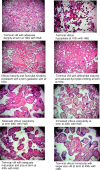Placental characteristics and neonatal weights among women with malaria-preeclampsia comorbidity and healthy pregnancies
- PMID: 37856468
- PMCID: PMC10586625
- DOI: 10.1371/journal.pone.0291172
Placental characteristics and neonatal weights among women with malaria-preeclampsia comorbidity and healthy pregnancies
Abstract
Background: Malaria and preeclampsia are leading causes of maternal morbidity and mortality in sub-Saharan Africa. They contribute significantly to poor perinatal outcomes like low neonatal weight by causing considerable placental morphological changes that impair placental function. Previous studies have described the effects of either condition on the placental structure but the structure of the placenta in malaria-preeclampsia comorbidity is largely understudied despite its high burden. This study aimed to compare the placental characteristics and neonatal weights among women with malaria-preeclampsia comorbidity versus those with healthy pregnancies.
Methodology: We conducted a retrospective cohort study among 24 women with malaria-preeclampsia comorbidity and 24 women with healthy pregnancies at a County Hospital in Western Kenya. Neonatal weights, gross and histo-morphometric placental characteristics were compared among the two groups.
Results: There was a significant reduction in neonatal weights (P<0.001), placental weights (P = 0.028), cord length (P<0.001), and cord diameter (P<0.001) among women with malaria-preeclampsia comorbidity compared to those with healthy pregnancies. There was also a significant reduction in villous maturity (P = 0.016) and villous volume density (P = 0.012) with increased villous vascularity (P<0.007) among women with malaria-preeclampsia comorbidity compared to those with healthy pregnancies.
Conclusion: Placental villous maturity and villous volume density are significantly reduced in patients with malaria-preeclampsia comorbidity with a compensatory increase in villous vascularity. This leads to impaired placental function that contributes to lower neonatal weights.
Copyright: © 2023 Lwamulungi et al. This is an open access article distributed under the terms of the Creative Commons Attribution License, which permits unrestricted use, distribution, and reproduction in any medium, provided the original author and source are credited.
Conflict of interest statement
The authors have declared that no competing interests exist.
Figures
References
MeSH terms
LinkOut - more resources
Full Text Sources
Medical



